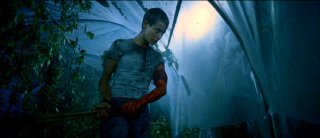4 Weeks of Halloween: Week 3
And the horror movie marathon continues (Week 1 | Week 2). This week’s program:
- Robot Chicken: The Time of the Great Pumpkin
- The Simpsons: Treehouse of Horror IV: The Devil & Homer Simpson (1993) “Mmmm, forbidden donut…”
- The Call of Cthulhu By H.P. Lovecraft (short story)
- 30 Days of Night (2007): Modern books and movies seem to romanticize the vampire. They’re all erotic, brooding, and emotional. So it’s nice to see a movie where they’re portrayed as, well, monsters. The vampires in this movie are brutal, cold blooded killers. They strike quickly, going for the jugular, then walk around with blood caked on their faces. They seem more like fast, intelligent versions of zombies than the modern whiney vampire. All that said, this movie doesn’t quite hit all the notes it needs to. It’s very well made, and I’ll give director David Slade credit for crafting some excellent sequences (particularly the overhead shots of the town as it is set upon by vampires towards the beginning of the film), but the high concept story (which is admittedly a cool idea) has plenty of holes and the ending is a bit of a letdown. This sort of thing doesn’t usually bother me, but I got the feeling that Josh Hartnett was wrong for this role. His character’s backstory didn’t have much time to percolate, so a better actor may have been able to establish something more with simple looks and body language. Again, cool villains, a neat idea, decent execution, but a story that leaves something to be desired. **1/2
- Phantasm (trailer)
- Phantasm II (trailer)
- In the Hills, the Cities by Clive Barker (short story from Books of Blood)
- High Tension (Haute tension) (2003): This French horror film is certainly a bloody affair, but there’s a lot to like about it and the film’s title has some merit to it. Everything that happens in the movie is completely unoriginal, but this isn’t just a splattery gore-fest. The filmmakers do attempt to build tension, and are reasonably effective at doing so. Sure, it’s derivative, but it’s very well made. Good acting, sharp art-house cinematography, and taut, suspenseful music are just a few elements. These filmmakers wear their influences on their sleeves, and for the most part, they get away with it (see this spoiler laden post for a bunch of side by side screenshot comparisons, and a pretty good discussion of the film). As with a lot of horror movies, there are a fair share of improbable events or decisions, but the astoundingly absurd twist towards the end of the film torpedoes what would have been a really great movie. The twist is a source of unending controversy and while I admit that there’s something neat about it, it is also totally reliant on the fact that the filmmakers are pretty much lying to you for 80 minutes. With such a flawed ending, it’s difficult to judge this film. I think it’s still worth watching for fans of the genre (it’s definitely not for the timid, as it’s quite gory) but I can’t decide how much the ending really takes away from the movie. After all, there’s not much of a story (plus, it’s a story we’ve seen a hundred times before (it reminded me a lot of Dean Koontz’s Intensity, for example)), and the main attraction is the suspense and horror established by what is essentially an 80 minute chase scene. I think I’m probably cutting it too much slack, but I’ll go with ***
- Halloween (1977) (trailer)
- In the Mouth of Madness (trailer)
- The Thing (trailer)
- “Masters of Horror” John Carpenter’s Cigarette Burns (2005): I was recently wondering what happened to John Carpenter. His last few films (Ghosts of Mars and Vampire$) were unbelievably bad films, and the best that could be said of his work in the 1990s is that it was uneven. This is a guy who had an incredible run in the late 1970s and early 1980s, making two of my favorite all time horror films (Halloween and The Thing) amongs several other good films. Anyway, I’d heard good things about his work on the Masters of Horror series, so I checked out this episode, summarized well on IMDB: “With a torrid past that haunts him, a movie-theater director is hired to hunt for the only known print of a film so notorious that its single screening caused the viewers to become homicidally insane.” It’s an intriguing mix of The Club Dumas and Carpenter’s own In the Mouth of Madness (probably his best film from the uneven 1990s). It doesn’t quite live up to it’s potential, but it’s entertaining enough, and it’s got it’s fair share of chills (and some effective extreme gore). It’s flawed, but another solid effort from this series and despite the fact that I don’t love this, I think I am now looking forward to Carpenter’s next film (two are apparently scheduled for 2008). He’s still able to craft truly creepy imagery, even if he may have lost his touch overall. **1/2
Update: Heh: Open Letter to the Aliens Who Kidnapped John Carpenter and Replaced Him With a Pod Person



